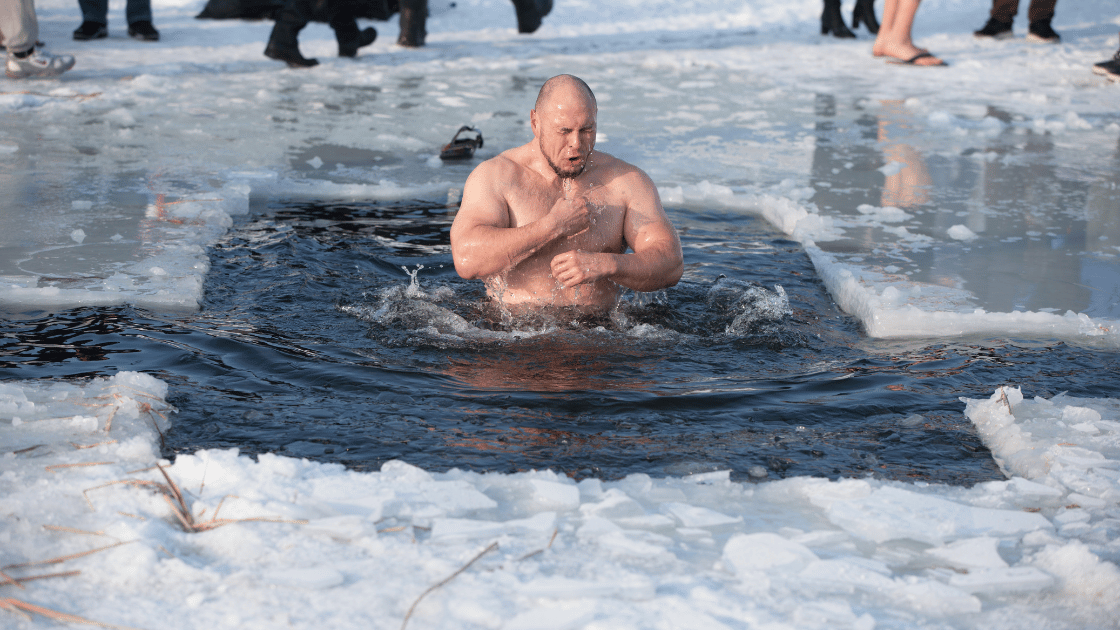What is Ice Bath: Health Benefits of Cold Therapy

Ice baths, also known as cold therapy or cold water immersion, have gained popularity in recent years as a recovery strategy for athletes and fitness enthusiasts. But what exactly is an ice bath, and why are so many people incorporating it into their fitness routines? In this article, we will delve into the world of ice baths and explore the science-backed health benefits they offer.
Definition and Explanation of Ice Baths
An ice bath involves immersing your body in cold water for a specified period. Typically, the water temperature ranges from 50 to 59 degrees Fahrenheit (10 to 15 degrees Celsius). The duration can vary from a few minutes to around 15 minutes, depending on personal preference and tolerance.
Importance of Cold Therapy for Muscle Recovery and Inflammation Reduction
Cold therapy, including ice baths, is believed to aid in muscle recovery and reduce inflammation. When you expose your body to cold temperatures, blood vessels constrict, which helps reduce swelling and inflammation in damaged tissues. Additionally, the cold temperature numbs nerve endings, providing temporary pain relief.
- Enhanced muscle recovery
- Decreased post-workout inflammation
- Temporary pain relief
Now that we’ve set the stage for our exploration of ice baths’ health benefits, let’s dive deeper into what exactly an ice bath entails.
What is an Ice Bath?
An ice bath, also known as cold water immersion (CWI), involves immersing your body in cold water for a specific duration. This practice is believed to have several health benefits, including:
- Muscle recovery aid: The cold temperature helps reduce inflammation and swelling in the muscles, which can speed up the recovery process after intense exercise.
- Reduction of soreness: Cold water immersion may help alleviate muscle soreness by numbing the area and reducing pain signals.
- Potential prophylactic effects against cardiovascular and metabolic diseases: Some studies suggest that regular exposure to cold temperatures can improve insulin sensitivity and reduce the risk of certain chronic conditions.
However, it’s important to note that scientific evidence on the health benefits of ice baths is limited, and there are potential risks associated with prolonged exposure to cold water. It is recommended to follow recommended guidelines for ice bath usage in terms of time and temperature.
How Does an Ice Bath Work?
An ice bath works by:
- Constricting blood vessels: The cold temperature causes blood vessels to narrow, which can help reduce swelling and inflammation in the muscles.
- Decreasing metabolic activity: The cold environment slows down metabolic processes in the body, which may help decrease tissue breakdown and damage.
- Flushing out lactic acid: Intense exercise can produce lactic acid, which can contribute to muscle fatigue. The sudden change in temperature from hot to cold in an ice bath is thought to help remove lactic acid from the muscles.
Who Can Benefit from Ice Baths?
Ice baths may be beneficial for individuals who:
- Engage in high-intensity workouts or sports activities
- Experience muscle soreness or inflammation after exercise
- Are looking for alternative methods to support muscle recovery
How to Take an Ice Bath
Here are some tips for taking an ice bath:
- Fill a bathtub or container with cold water, typically with temperatures ranging from 10 to 15 degrees Celsius (50 to 59 degrees Fahrenheit).
- Immerse your body in the water up to your waist or shoulders, depending on your comfort level.
- Stay in the ice bath for about 10-15 minutes.
- Gradually increase the duration and frequency of ice baths as your body adjusts to the cold temperature.
Ice Bath vs. Other Cold Therapies
While ice baths are a popular form of cold therapy, there are other options available that may offer similar benefits:
- Cold showers: Taking a cold shower after exercise can provide some of the benefits of an ice bath, such as reducing muscle soreness and improving circulation.
- Ice packs or cold compresses: Applying ice packs or cold compresses to specific areas of the body may help target localized pain or inflammation.
Precautions and Potential Risks
It’s important to take precautions when using ice baths:
- Do not use ice baths if you have any underlying medical conditions, such as Raynaud’s disease or circulatory disorders, without consulting a healthcare professional.
- Avoid prolonged exposure to extremely cold temperatures, as it can lead to hypothermia or frostbite.
- Listen to your body and discontinue the ice bath if you experience severe discomfort, numbness, or prolonged shivering.
If you’re unsure whether ice baths are suitable for you, it’s best to consult with a healthcare professional or sports therapist before incorporating them into your routine.
1. How to Perform an Ice Bath Safely
An ice bath, also known as cold water immersion or CWI, is a therapeutic practice that involves immersing your body in cold water for a specific duration. It has become popular among athletes and fitness enthusiasts for its potential benefits in muscle recovery and reducing inflammation. Here, we will explore the science-backed health benefits of ice baths and discuss precautions to keep in mind when using this form of cold therapy.
Benefits of Cold Water Immersion for Muscle Recovery
Ice baths are widely used for muscle recovery due to their ability to reduce inflammation and promote blood flow to damaged tissues. When you expose your body to cold water, it constricts blood vessels and reduces the flow of blood to the muscles. This vasoconstriction helps alleviate swelling and inflammation caused by intense exercise or physical activity.
Additionally, cold water immersion triggers a response in your body known as the “hunting response.” This is a natural mechanism where your blood vessels constrict temporarily, followed by vasodilation (expansion) once you remove yourself from the cold water. This alternating constriction and dilation of blood vessels promotes circulation and enhances the delivery of oxygen and nutrients to your muscles, aiding in their recovery process.
Scientific studies have supported the effectiveness of cold water immersion for enhancing post-exercise healing processes. For example, a study published in the Journal of Science and Medicine in Sport found that athletes who used ice baths after intense exercise experienced reduced muscle soreness compared to those who didn’t use this therapy. Another study published in the European Journal of Applied Physiology showed that ice baths significantly reduced markers of muscle damage following eccentric exercise.
Precautions for Safe Ice Bath Usage
While ice baths can be beneficial for muscle recovery, it’s important to take certain precautions to ensure your safety and maximize the potential benefits:
1. Duration and temperature
The recommended duration for an ice bath session is typically around 10-15 minutes. The optimal water temperature ranges from 50 to 59 degrees Fahrenheit (10 to 15 degrees Celsius). It’s crucial not to exceed these time and temperature recommendations to avoid adverse effects.
2. Gradual acclimation
If you’re new to ice baths, it’s best to gradually acclimate your body to colder temperatures over time. Start with shorter durations and slightly higher water temperatures, then gradually decrease the temperature and increase the duration as your body adapts.
3. Monitoring discomfort levels
Pay attention to your comfort level throughout the session. It’s normal to experience a sensation of coldness, but if you start experiencing severe discomfort, numbness, or other unusual sensations, it’s important to end the session immediately.
4. Consultation with healthcare professionals
If you have any underlying health conditions or concerns, it’s recommended to consult with a healthcare professional before incorporating ice baths into your routine. Certain medical conditions such as cardiovascular problems, Raynaud’s disease, or cold urticaria (allergic reaction to cold temperatures) may require special considerations or even contraindicate ice bath usage.
Remember, safety should always be a priority when performing an ice bath. Following these precautions will help you minimize risks and maximize the potential benefits of this cold therapy technique.
Other Potential Health Benefits of Ice Baths
Ice baths, also known as cold water immersion (CWI), have been associated with various additional advantages beyond muscle recovery. Let’s explore some of these benefits:
1. Decreased post-workout inflammation
Ice baths are believed to help reduce inflammation after intense exercise. When the body is exposed to cold temperatures, the blood vessels constrict, which can help decrease swelling and inflammation in the muscles. This reduction in inflammation can lead to faster recovery and improved exercise performance.
2. Lowering core body temperature
Ice baths can be particularly beneficial during intense physical activity or in hot environments. By immersing yourself in cold water, you can rapidly lower your core body temperature, helping to prevent overheating and heat-related illnesses. This cooling effect can be especially useful for athletes or individuals who engage in prolonged strenuous activities.
3. Potential immune-boosting effects
Cold exposure has been shown to activate the body’s defense mechanisms, potentially boosting the immune system. Some studies suggest that regular ice baths may enhance the production of white blood cells and other immune factors, providing a potential protective effect against infections and illnesses.
4. Mental well-being
In addition to its physical benefits, ice baths can also have a positive impact on mental health. The shock of cold water immersion triggers the release of endorphins, which are natural mood enhancers that can promote feelings of relaxation and well-being. Ice baths have been reported to reduce stress levels, improve mood, and even alleviate symptoms of depression.
“Cold water immersion has been associated with decreased post-exercise inflammation, lowered core body temperature during intense physical activity or in hot environments, potential immune-boosting effects, and positive impacts on mental well-being.”
While these potential health benefits are promising, it’s important to note that more research is needed to fully understand the mechanisms behind them and their long-term effects on overall health.
To get the most out of your ice bath experience, it’s important to follow proper guidelines and safety precautions. Here are some tips to keep in mind:
- Gradually acclimate your body to colder temperatures over time. Start with shorter durations and gradually increase as you become more comfortable.
- Monitor your comfort level throughout the session. If you experience severe discomfort, numbness, or prolonged shivering, it’s important to end the ice bath and warm up immediately.
- Ensure that the water temperature is not too extreme. Generally, a temperature range of 10-15 degrees Celsius (50-59 degrees Fahrenheit) is recommended for ice baths.
- Always consult with a healthcare professional before incorporating ice baths into your routine, especially if you have any underlying health conditions or concerns.
“To ensure a safe and effective ice bath experience, gradually acclimate your body to colder temperatures, monitor your comfort level throughout the session, and consult with a healthcare professional if you have any concerns.”
Using Ice Baths for Pain Management and Certain Conditions
Ice baths, also known as cold water immersion (CWI), have been found to provide relief for individuals with specific health issues like gout or chronic pain. While there is anecdotal evidence supporting these claims, it is crucial to consult a healthcare professional before incorporating ice baths into any treatment plan.
Gout Relief
Gout is a form of arthritis caused by the buildup of uric acid crystals in the joints. It often leads to severe pain and inflammation. Ice baths can help alleviate the symptoms of gout by:
- Reducing inflammation: The cold temperature of the water constricts blood vessels and decreases blood flow to the affected area. This can help reduce swelling and inflammation, providing temporary pain relief.
- Numbing the area: Cold temperatures can numb nerve endings, reducing the sensation of pain in the affected joint.
It is important to note that ice baths should not replace medical treatment for gout. They can be used as a complementary therapy to help manage symptoms and provide temporary relief.
Chronic Pain Management
Ice baths can also be beneficial for individuals experiencing chronic pain. Cold therapy has been shown to have analgesic effects by:
- Decreasing nerve activity: The cold temperature can slow down nerve conduction, reducing the transmission of pain signals to the brain.
- Reducing muscle spasms: Cold therapy helps relax muscles and relieve tension, which can contribute to chronic pain.
Again, it is crucial to consult with a healthcare professional before using ice baths as a treatment for chronic pain. They can provide guidance on how to incorporate cold therapy into your pain management plan safely.
Safety Tips
When using ice baths for pain management or any other condition, it’s important to follow these safety tips:
- Gradually acclimate your body: Start with shorter durations and higher water temperatures before gradually increasing the time and lowering the temperature. This allows your body to adjust to the cold gradually and minimizes the risk of discomfort or injury.
- Monitor your comfort level: Pay attention to any signs of severe discomfort, numbness, or prolonged pain during the ice bath. If you experience any of these symptoms, it’s important to end the session immediately and seek medical attention if necessary.
- Protect extremities: To prevent potential damage from prolonged exposure to cold temperatures, consider wearing gloves and socks during the ice bath.
- Stay hydrated: Cold therapy can cause vasoconstriction, which may increase blood pressure. Make sure to drink plenty of fluids before and after the ice bath to stay hydrated.
Remember, while ice baths can be beneficial for certain conditions, they are not suitable for everyone. It is essential to consult with a healthcare professional who can assess your individual needs and provide guidance on whether ice baths are appropriate for you.
Continue reading the article to learn more about understanding the risks associated with ice baths and best practices for a safe and effective ice bath experience.
Understanding the Risks: Who Should Avoid Ice Baths?
When it comes to ice baths, it’s important to know that they may not be suitable for everyone. Certain individuals with specific health conditions should approach or avoid this form of cold therapy with caution. Here are the factors you should consider:
1. Cardiovascular Problems
If you have issues with your heart or high blood pressure, you should be careful when thinking about trying ice baths. The sudden exposure to cold temperatures can cause your blood vessels to narrow, which may increase your blood pressure and put extra stress on your heart.

2. Raynaud’s Disease and Circulatory Disorders
People with Raynaud’s disease or other circulatory disorders should also be cautious with ice baths. Raynaud’s disease causes your blood vessels in your fingers and toes to constrict excessively when exposed to cold or emotional stress. Ice baths can make this condition worse. Likewise, individuals with other circulatory disorders may experience negative effects because their blood vessels constrict too much in response to the cold.
3. Cold Urticaria
If you have cold urticaria, which is an allergic reaction to cold temperatures, you should avoid ice baths altogether. This condition can lead to symptoms like hives, swelling, and in severe cases, anaphylaxis when your skin comes into contact with cold things.
By understanding these potential risks, you can make informed decisions about whether ice baths are suitable for you. If you fall into any of these categories, it may be best to explore alternative forms of recovery and relaxation that don’t involve exposure to extreme cold temperatures.
Best Practices for a Safe and Effective Ice Bath Experience
Expert recommendations to minimize risks and maximize benefits when using ice baths, including:
- Gradually acclimating your body to colder temperatures over time.
- Monitoring your comfort level throughout the session and ending it if you experience severe discomfort or numbness.
When incorporating ice baths into your recovery routine, it’s crucial to prioritize safety and effectiveness. Here are some best practices to ensure a positive experience:
Gradual Acclimation
To minimize the shock of cold water immersion, gradually acclimate your body to lower temperatures over time. Start with shorter sessions in lukewarm water before progressing to colder temperatures. This approach allows your body to adapt and reduces the potential for extreme discomfort during the ice bath.
Comfort Monitoring
During an ice bath session, pay close attention to your comfort level. If you experience severe discomfort, numbness, or prolonged shivering, it may be a sign that the temperature is too cold or that the duration is excessive. Listen to your body and prioritize safety by ending the session if needed. It’s essential to strike a balance between challenging yourself and avoiding potential harm.
By following these best practices, you can optimize the safety and effectiveness of your ice bath experience, promoting enhanced muscle recovery and overall well-being.
Making the Most of Cold Therapy: Tips to Enhance Your Ice Bath Routine
To optimize your experience with ice baths and maximize their benefits, here are some practical suggestions to consider:
1. Combine cold immersion with active recovery techniques
After your ice bath, incorporate gentle stretching or foam rolling exercises. These activities can help promote blood flow, reduce muscle stiffness, and enhance the overall recovery process. By actively engaging your muscles post-immersion, you can further alleviate soreness and enhance muscle repair.
2. Try contrast therapy
Alternating between hot and cold treatments can provide additional benefits for healing and recovery. Contrast therapy involves switching between cold water immersion and warm water or heat application. The alternating temperatures help to stimulate blood circulation, reduce inflammation, and improve tissue repair.
Note: It’s important to consult with a healthcare professional before attempting contrast therapy, as it may not be suitable for everyone, especially those with certain medical conditions.
3. Monitor your body’s response
Pay attention to how your body reacts during the ice bath session. While it is normal to feel a cold sensation and mild discomfort initially, severe discomfort or numbness may indicate that the water temperature is too cold or that you have been immersed for too long. Listen to your body and end the session if you experience any signs of distress.
4. Gradually increase exposure time
If you are new to ice baths, start with shorter durations (e.g., 1-2 minutes) and gradually increase the time as your body becomes accustomed to the cold temperatures. This gradual acclimation helps minimize the shock to your system and allows you to adapt more comfortably.
Tip: Use a timer or stopwatch to track your immersion time and ensure consistency in each session.
5. Maintain proper hydration
Cold water immersion can cause vasoconstriction and increase the workload on your heart. It is important to stay hydrated before and after your ice bath to support cardiovascular function and help your body regulate temperature effectively.
6. Consider post-ice bath nutrition
Consuming a balanced meal or snack after your ice bath can support muscle recovery and replenish energy stores. Opt for a combination of carbohydrates and protein to aid in muscle repair and glycogen replenishment.
By incorporating these tips into your ice bath routine, you can enhance the effectiveness of cold therapy and maximize its benefits for muscle recovery, inflammation reduction, and overall well-being. Remember to always listen to your body’s cues and consult with a healthcare professional if you have any underlying medical conditions or concerns.
Explore Other Cold Therapy Options
Alternatives to Ice Bath
When considering cold therapy options, it’s important to explore alternatives to ice baths. These alternatives offer flexibility and cater to individual preferences for cold exposure. Here are some options you can consider:
- Cold Showers: Cold showers provide a convenient and accessible form of cold therapy. They offer a quick way to experience the benefits of cold exposure without the need for extensive preparation. Many people find cold showers invigorating and use them as a regular part of their wellness routine.
- Cryotherapy Sessions: For those seeking a more controlled and intense cold therapy experience, cryotherapy sessions at specialized clinics are an option. Cryotherapy involves exposing the body to extremely low temperatures for a short duration, typically in a specialized chamber. This form of cold therapy is gaining popularity for its potential benefits in reducing inflammation and promoting recovery.
- Topical Application: Alternatively, targeted application of cold packs or gels can deliver localized cold therapy to specific areas of the body. This approach is useful for addressing sore muscles or joint discomfort without requiring full-body immersion in cold water.
By exploring these alternative options, individuals can find the right fit for their cold therapy needs and preferences, ensuring that they can incorporate the benefits of cold exposure into their wellness routine effectively.
Conclusion
In conclusion, ice baths, also known as cold water immersion (CWI), offer several potential health benefits for muscle recovery, inflammation reduction, and overall well-being. While the scientific evidence on the effectiveness of ice baths is limited, many athletes and fitness enthusiasts have reported positive experiences with this form of cold therapy.
Here are some key takeaways:
Professional guidance is essential
If you’re considering incorporating ice baths into your recovery routine, it’s crucial to seek guidance from a healthcare professional or a qualified trainer. They can provide personalized recommendations based on your specific needs and goals.
Listen to your body
Everyone’s response to cold therapy can vary. Pay attention to how your body reacts during and after an ice bath session. If you experience severe discomfort, numbness, or any other concerning symptoms, stop immediately and consult a healthcare professional.
Experimentation is key
Ice baths may not be suitable for everyone. It’s important to experiment and assess whether this recovery strategy works for you. Some individuals may find alternative forms of cold therapy more comfortable or effective.
Overall, ice baths can be a valuable tool in your recovery arsenal when used safely and appropriately. Remember to combine them with other recovery techniques, such as active stretching or foam rolling, and consider exploring alternative cold therapy options like cryotherapy or topical applications. By taking a holistic approach to recovery, you can optimize your performance and enhance your overall well-being.
So go ahead, give ice baths a try if you’re intrigued by the potential benefits. Just ensure that you do so under professional guidance and always prioritize your body’s response and comfort level. Stay cool!








